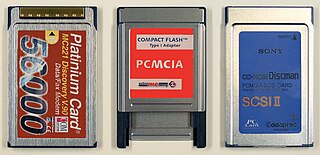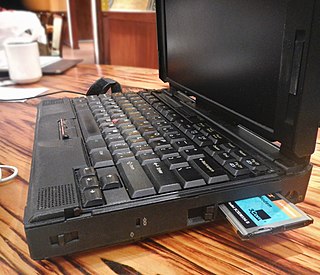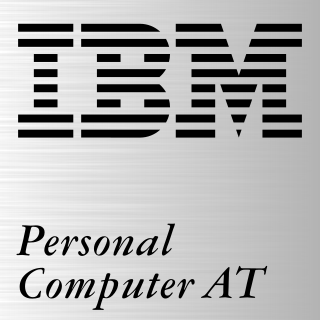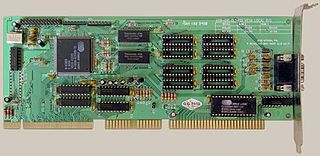
Industry Standard Architecture (ISA) is the 16-bit internal bus of IBM PC/AT and similar computers based on the Intel 80286 and its immediate successors during the 1980s. The bus was (largely) backward compatible with the 8-bit bus of the 8088-based IBM PC, including the IBM PC/XT as well as IBM PC compatibles.

PC Card is a parallel peripheral interface for laptop computers and PDAs. The Personal Computer Memory Card International Association (PCMCIA) originally introduced the 16-bit ISA-based PCMCIA Card in 1990, but renamed it to PC Card in March 1995 to avoid confusion with the name of the organization. The CardBus PC Card was introduced as a 32-bit version of the original PC Card, based on the PCI specification. The card slots are backward compatible for the original 16-bit card, older slots are not forward compatible with newer cards.

Static random-access memory is a type of random-access memory (RAM) that uses latching circuitry (flip-flop) to store each bit. SRAM is volatile memory; data is lost when power is removed.

The Amiga 600, also known as the A600, is a home computer introduced in March 1992. It is the final Amiga model based on the Motorola 68000 and the 1990 Amiga Enhanced Chip Set. A redesign of the Amiga 500 Plus, it adds the option of an internal hard disk drive and a PCMCIA port. Lacking a numeric keypad, the A600 is only slightly larger than an IBM PC keyboard, weighing approximately 6 pounds (2.72kg). It shipped with AmigaOS 2.0, which was considered more user-friendly than earlier versions of the operating system.

The Personal Computer Memory Card International Association (PCMCIA) was a group of computer hardware manufacturers, operating under that name from 1989 to 2009. Starting with the PCMCIA card in 1990, it created various standards for peripheral interfaces designed for laptop computers.

In computing, an expansion card is a printed circuit board that can be inserted into an electrical connector, or expansion slot on a computer's motherboard to add functionality to a computer system. Sometimes the design of the computer's case and motherboard involves placing most of these slots onto a separate, removable card. Typically such cards are referred to as a riser card in part because they project upward from the board and allow expansion cards to be placed above and parallel to the motherboard.

A DIMM, or Dual In-Line Memory Module, is a popular type of memory module used in computers. It is a printed circuit board with one or both sides holding DRAM chips and pins. The vast majority of DIMMs are standardized through JEDEC standards, although there are proprietary DIMMs. DIMMs come in a variety of speeds and sizes, but generally are one of two lengths - PC which are 133.35 mm (5.25 in) and laptop (SO-DIMM) which are about half the size at 67.60 mm (2.66 in).

The Enhanced Graphics Adapter (EGA) is an IBM PC graphics adapter and de facto computer display standard from 1984 that superseded the CGA standard introduced with the original IBM PC, and was itself superseded by the VGA standard in 1987. In addition to the original EGA card manufactured by IBM, many compatible third-party cards were manufactured, and EGA graphics modes continued to be supported by VGA and later standards.

A memory card is an electronic data storage device used for storing digital information, typically using flash memory. These are commonly used in digital portable electronic devices, such as Digital cameras as well as in many early games consoles such as the Nintendo Wii. They allow adding memory to such devices using a card in a socket instead of protruding USB flash drives.

CompactFlash (CF) is a flash memory mass storage device used mainly in portable electronic devices. The format was specified and the devices were first manufactured by SanDisk in 1994.

The IBM Personal Computer AT was released in 1984 as the fourth model in the IBM Personal Computer line, following the IBM PC/XT and its IBM Portable PC variant. It was designed around the Intel 80286 microprocessor.

Super VGA (SVGA) is a broad term that covers a wide range of computer display standards that extended IBM's VGA specification.

ExpressCard, initially called NEWCARD, is an interface to connect peripheral devices to a computer, usually a laptop computer. The ExpressCard technical standard specifies the design of slots built into the computer and of expansion cards to insert in the slots. The cards contain electronic circuits and sometimes connectors for external devices. The ExpressCard standard replaces the PC Card standards.

Thin small outline package (TSOP) is a type of surface mount IC package. They are very low-profile and have tight lead spacing.

In computing, a memory module or RAM stick is a printed circuit board on which memory integrated circuits are mounted.

The Amiga 1200, or A1200, is a personal computer in the Amiga computer family released by Commodore International, aimed at the home computer market. It was launched on October 21, 1992, at a base price of £399 in the United Kingdom and $599 in the United States.
The ATI Wonder is a series of video cards for the IBM Personal Computer and compatibles, introduced by ATI Technologies in the mid to late 1980s. These cards were unique at the time as they offered the end user a considerable amount of value by combining support for multiple graphics standards into a single card. The VGA Wonder series added additional value with the inclusion of a bus mouse port, which normally required the installation of a dedicated Microsoft Mouse adapter.

The IBM Personal Computer XT is the second computer in the IBM Personal Computer line, released on March 8, 1983. Except for the addition of a built-in hard drive and extra expansion slots, it is very similar to the original IBM PC model 5150 from 1981.

Cumulus Corporation was an American computer peripheral and system manufacturer active from 1987 to 1993. Based in Beachwood, Ohio and started by Tecmar founder Martin Alpert, the company set out to exclusively manufacture expansion products for IBM's Personal System/2 (PS/2) family of computers—mainly RAM expansion cards. It later released cross-platform CPU upgrade cards and memory expansion cards for other platforms besides the PS/2. Beginning in 1990, the company began trading as Cumulus Computer Corporation and began releasing complete systems of their own. Initially a success story for the tech industry in Cleveland, a botched stock launch in 1992 proved disastrous for the company's ailing cash flow situation, and in 1993 the company was liquidated amid massive debt to suppliers and lenders.
New Media Corporation, also known as New Media Technology Corporation, was an American computer company active from 1992 to the early 2000s. The company focused on the design and manufacture of PC Cards, a type of expansion card bus for laptops that had their heyday from the early 1990s to the mid-2000s. New Media was privately held and based out of Irvine, California.



















